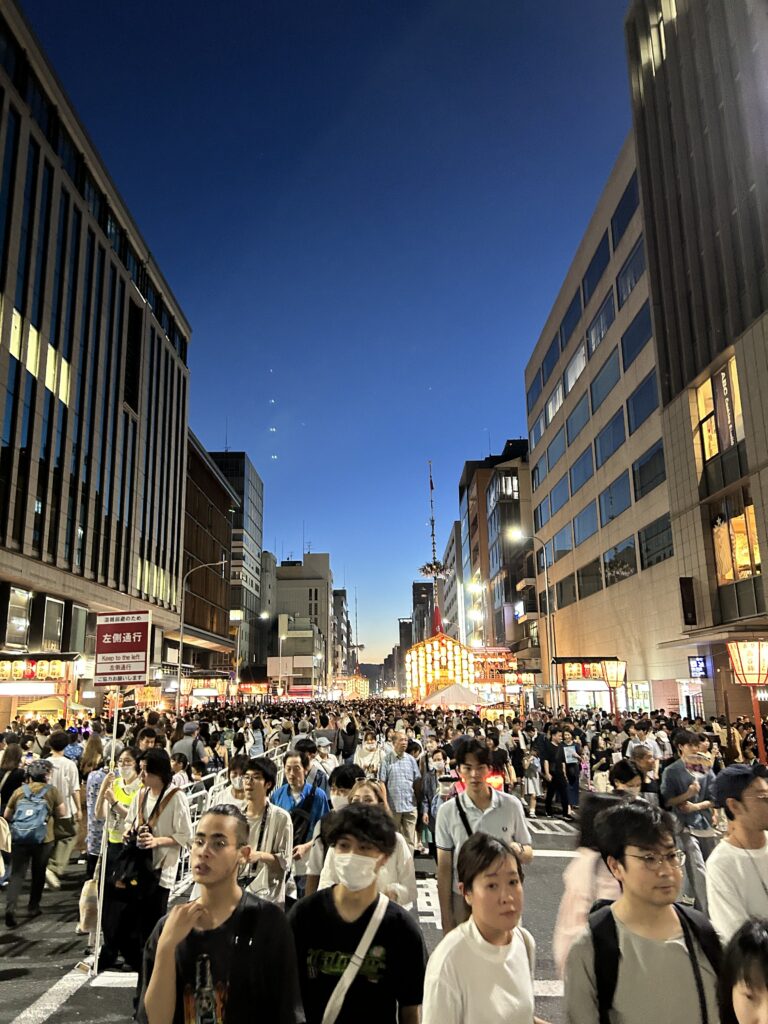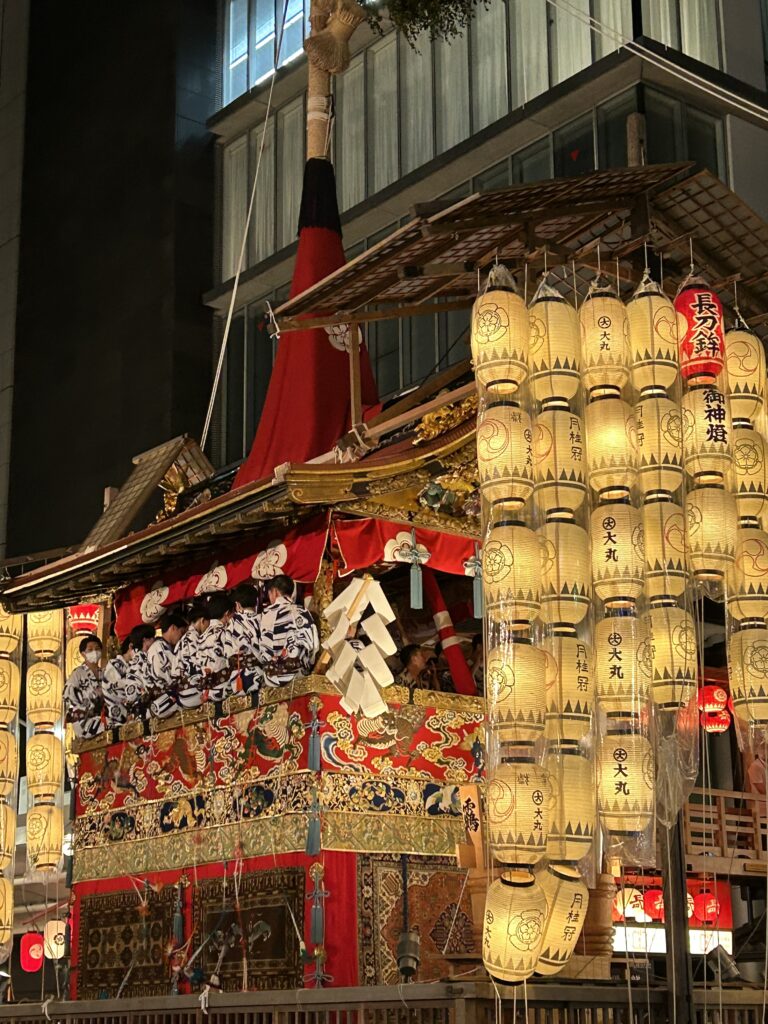This article is a web original.
Monica Narang (Osaka)
As I stood in the middle of the crowd of two hundred thousand people, I felt amazed that I was attending one of the oldest and most extraordinary festivals in the world!
The extraordinary Gion Matsuri Festival in Kyoto resumed after a three-year hiatus due to the pandemic and I was lucky enough to be smack dab in the middle of all the action. I looked up to see massive towering 80-foot-tall floats surrounding me on both sides.
Over fifteen floats stretched all the way down the main Shijo Dori street in Kyoto while the smaller floats were tucked away on side alleys and streets. Summer festivals were in their full glory in Japan this year because all of the pandemic restrictions had been lifted and I was eager to attend as many as I could throughout the Kansai region!
Members of the community of all ages sat atop each giant float and played a medley of bells, gongs, and drums in unison. The rhythm of kon chikki chikki kon rang in my ears as I went float hopping and admired the lavish treasures and tapestries that adorned each float. On the Fune Boko, or “Boat Float” in English, I had the opportunity to climb a narrow stairwell and actually sit on the top of the gigantic boat-shaped float while listening to the musicians play a medley of gongs, bells, & drums up close!
I filmed and photographed all of my adventures and shared these across social media so that the international community could feel as though they were experiencing the festival alongside me. I learned intricate details about Gion Matsuri—including vivid and legendary stories behind each float. During the three-day-long Yoiyama celebration (one of the main parts of the Gion Matsuri), hundreds of thousands of people flowed onto the streets to listen to music and enjoy delicious snacks from stalls selling yakitori, okonomiyaki, taiyaki, and more. People dressed in their colorful summer yukatas and children wore cool jinbeis (a special shirt and pair of shorts with unique prints on them).
Gion Matsuri takes place during the entire month of July. During the last week of the festival, I witnessed massive golden portable shrines lifted and paraded through the streets by men dressed in white long-sleeved shirts with emblems on each shirt and shorts. They cried out boisterously and in unison “hoito hoito” as they made their way through narrow streets. The festival-goers then walked with them at midnight as the final portable shrine made its way down the thoroughfare to the main Yasaka Jinja shrine, its final resting place.
It was truly an unforgettable moment to see the strength and pure energy of the men as we made our way down Shijo Dori Street together!
Attending Gion Matsuri was a once-in-a-lifetime experience which I will never forget! From listening to the musical voices of children chanting sweetly to sell bushels of lucky bamboo strips called “chimaki” to indulging in stall food to seeing the carpenters assemble each float from scratch without any nails and using only ropes, the entire month of July was definitely a set of memorable experiences!
On August 16th the Gozan Okuribi Bonfire Festival, which is also known as Daimonji, was held in the mountains of Kyoto—which is also known as Daimonji. This festival honored the souls of ancestors who passed away and was a part of the large Obon Festival in Japan. Kanji symbols and characters were lit as special bonfires on five major mountains (go means five in Japanese) in Kyoto. The lighting of each character symbolized an important meaning.
Oban is celebrated across Japan during August. People commemorated their ancestors by hanging lanterns in front of houses to guide them in this world. Bon Odori are large group dances and community members danced in a circle around singers who were on a stage in the middle of the circle. I participated in a lively Bon Odori dance and enjoyed learning new dance moves along with hand movements from community members! Even though the weather was scorching hot, I felt refreshed dancing in the cool breeze during a full moon night with my new friends. I felt connected to those around me as we danced in step to the voice of the singers and the musical beats. I will always treasure my incredible Bon Odori dance experience!
All of these festivals were magical events and I was thrilled to finally see them for the first time ever!
The entire city of Kyoto came to life during the summer and people were eager to celebrate after a long hiatus.
Monica Narang has over five years of experience in teaching and photography in Japan, India, and the United States. One of the things that she’s enjoyed most through her career is when she spoke to teachers at conferences around the world about the education system in the United States, India, and Japan. You can view her Instagram feed @mopica to see her festival journey across Kansai this past summer.

Photo 1: A view of the kanji character Dai (大) being lit on fire during the Daimonji or Gozan Okuribi Festival on August 16th to honor departed ancestors during the height of the Obon Festival.

Photo 2: The Fune Boko float or ship-shaped float made its way down Shijo Dori during the Gion Matsuri procession on July 17, 2023.

Photo 3: Prior to the main procession, the floats are all displayed on Shijo Dori and the small streets so that people can view them during the daytime and nighttime. This part of the festival is known as Yoiyama. I listened to Gion Bayashi music composed of gongs, bells, and drums as I strolled along the streets admiring the floats.

Photo 4: I witnessed the procession of mikoshi or portable golden shrines on July 24, 2023. Men dressed in traditional white tunics with emblems and shorts or loincloths (fundoshi) chanted ”hoito hoito” boisterously throughout the streets. They finally took the mikoshi to the main resting spot at Yasaka Jinja (shrine).

Photo 5: Community guilds came together to construct the floats quickly using only wooden frames, wooden nails, and rope to bind the pieces together. Here they are working on completing a boat float.

Photo 6: The Naginata Boko was the first float in the Gion Matsuri procession. Each float had a legendary story behind it. Some of the massive floats were 80 feet tall! It was impressive to watch these giant floats being pulled by the community members!

Photo 7: Mōsō Yama was one of the smaller, but equally majestic floats with a legendary story behind it. The stunning craftsmanship for each float was evident through all of the gorgeous tapestries and statues adorning the float.

Photo 8: Gion Matsuri resumed in all its full glory after four years of pandemic restrictions. The Yoiyama celebrations had many food stalls along with all the floats displayed on the main street. It was truly an unforgettable event and 250,000 people came out for Gion Matsuri this year!

Photo 9: During the month-long Gion Matsuri Festival, the mikoshi were placed in the center of Shijo so that people could offer their prayers. Finally, on July 24th, they were carried back to the main Yasaka Jinja (shrine) during a procession.

Photo 10: During the Obon Festival in mid-August communities came together for a special dance with coordinated hand and feet movements. Singers and musicians performed in the center of the circle on a stage while everyone danced around them.




